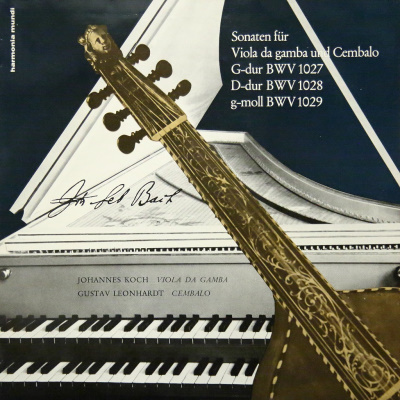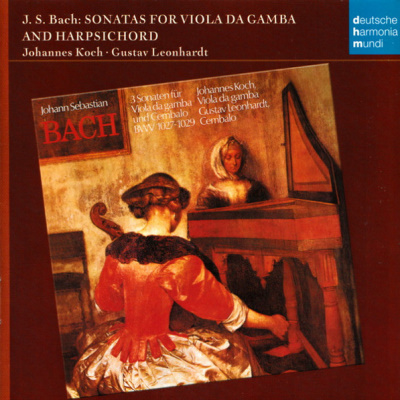 |
|
1 LP -
HM 30 648 - (p) 1963
|
 |
| 1 CD -
82876 70045 2 - (c) 2005 |
|
SONATAS FOR
VIOLA DA GAMBA AND HARPSICHORD
|
|
|
|
|
|
|
|
| Johann Sebastian
BACH (1685-1750) |
Sonata
for viola da gamba and hapsichord in G
major, BWV 1027
|
|
13' 21" |
|
|
-
Adagio
|
3' 53" |
|
A1 |
|
- Allegro ma non
tanto
|
3' 48" |
|
A2
|
|
-
Andante
|
2' 28" |
|
A3 |
|
- Allegro moderato |
3' 12" |
|
A4 |
|
Sonata for viola
da gamba and harpsichord in D
major, BWV 1028 |
|
13' 37" |
|
|
-
Adagio
|
1' 52" |
|
A5 |
|
-
Allegro |
2' 49" |
|
A6 |
|
-
Andante |
4' 34" |
|
B1 |
|
-
Allegro |
4' 22" |
|
B2 |
|
Sonata for viola
da gamba and harpsichord in G
minor, BWV 1029
|
|
13' 15" |
|
|
-
Vivace
|
5' 26" |
|
B3 |
|
-
Adagio
|
3' 47" |
|
B4 |
|
-
Allegro
|
4' 02" |
|
B5 |
|
|
|
|
|
| Johannes Koch,
Viola da gamba (Joachim Tielke, Hamburg
1677?) |
|
| Gustav Leonhardt,
Hapsichord (Martin Skowroneck, Bremen
1962 after the manner of J. D. Dulcken,
Antwerp 1745) |
|
|
|
|
|
Luogo
e data di registrazione |
|
Breukelen, Utrecht
(Holland) - settembre 1963 |
|
|
Registrazione: live
/ studio |
|
studio |
|
|
Recording
Supervision |
|
Dr. Alfred Krings
|
|
|
Prima Edizione LP |
|
Harmonia Mundi | HM
30 648 | 1 LP - durata 40' 31" |
(p) 1963
|
|
|
Edizione CD |
|
Deutsche Harmonia
Mundi | LC 00761 | 02876 70045 2 |
1 CD - durata 40' 31" | (c) 2005 |
ADD
|
|
|
Cover Art
|
|
-
|
|
|
Note |
|
-
|
|
|
|
|
Among Bach's
compositions three sonatas
for gamba and concertante
harpsichord have come down
to us; yet there are
deficiencis in our knowledge
of how they came to be
writte,. They would appear
to have been written in
Bach's Cöthen period, that
is between 1717 and 1723,
particularly as Prince
Leopold of Anhalt-Cöthen was
himself a zealous gamba
player. All three sonatas
belong to the trio-sonata
category, since - with a few
exceptions which realise the
instruments possibilities
for multiple stopping - they
at times develop three
independent lines, i.e. 1.
gamba, 2. right and 3. left
hand of the harpsichord
part.
The 1sr sonata in G major is
the re-casting of an earlier
Bach composition. We know it
as a trio for two flutes and
continuo, without being able
to state whether this in
fact represents the first
fradt; but the gamba version
has gained substantially not
only by the instrumentation
(the second flute part being
set here an octave lower for
the gamba) but also by a
multiplicity of
compositional refinements.
With its four-movement
pattern it bears the stamp
of the slow/quick/slow/quick
form of the Baroque "sonata
da chiesa", with a use of a
popular melodic content in
the quick fugato movements.
The 2nd sonata belongs in
form to the same category.
In its skilful technical
exploitation of the two
instruments iy may well be
taken as the original
composition. Its particular
charm consists in the
application of concertante
stylistic elements: no
longer do both the quick
movements begin with
imitative voices following
one upon the other, and in
the harpsichord passages of
the 4th movement there is a
distinct reminder of the
virtuoso figures of the 5th
Brandenburg.
Something announced first in
the 2nd sonata appears in
completed form in the 3rd:
the fusion of sonata and
concerto form. To purely
outward appearances the
three-movement
quick/low/quick concerto
pattern is evident. The very
thematic pattern of the 1st
movement however is a
palpable reminder of the 3rd
Brandenburg, and we do not
know whether of not perhaps
a (vanished) original
concerto movement of Bach's
is latent within this
movement, a special feature
of this being two
interpolated "cantabile"
interludes. Very seldom does
Bach employ this stylistic
device, - something wholly
"modern" for his day - and
again it is assuredly no
accident that we come across
one of the passages of this
type in the 5th Brandenburg
(3rd movement).
Dr.
Alfred Dürr
|
  |
|
|